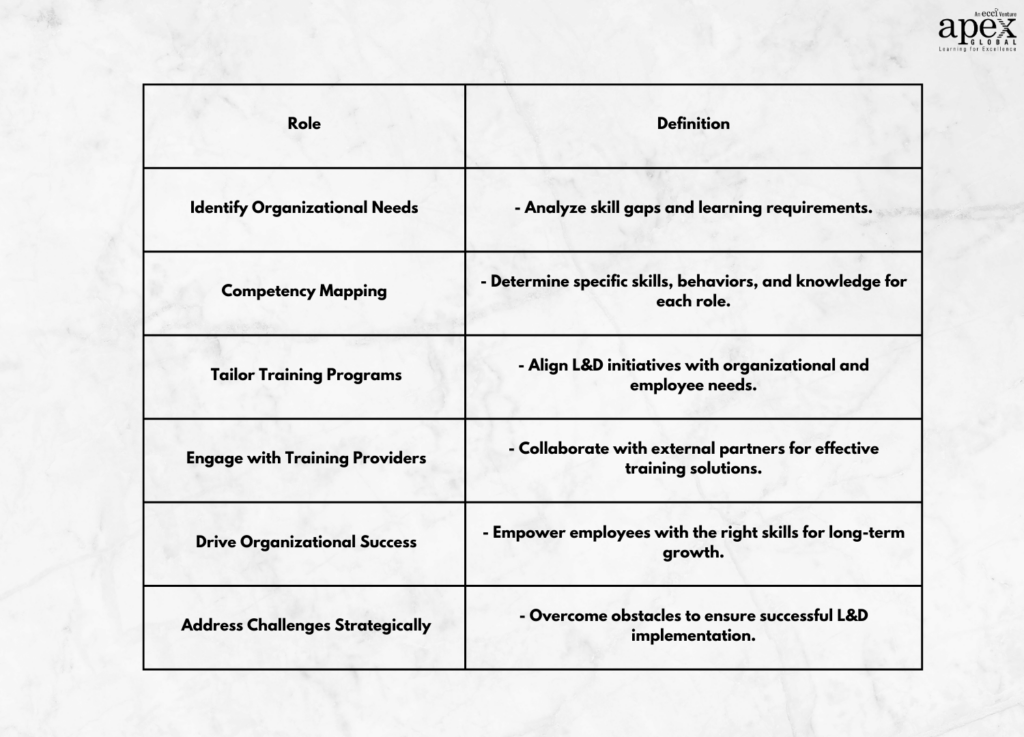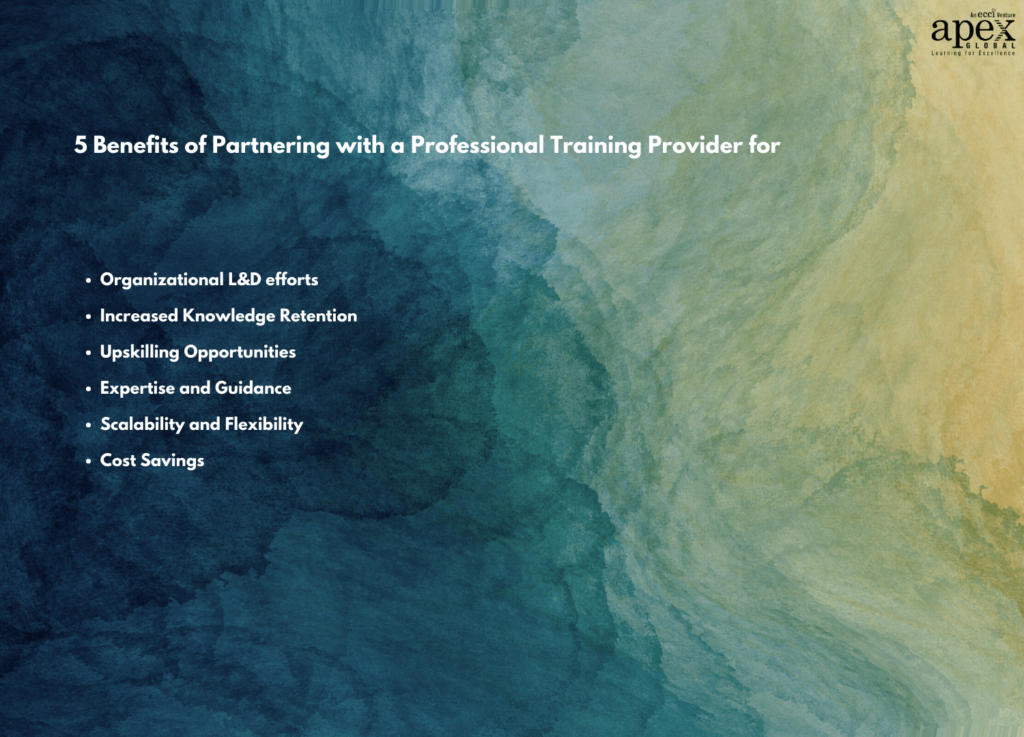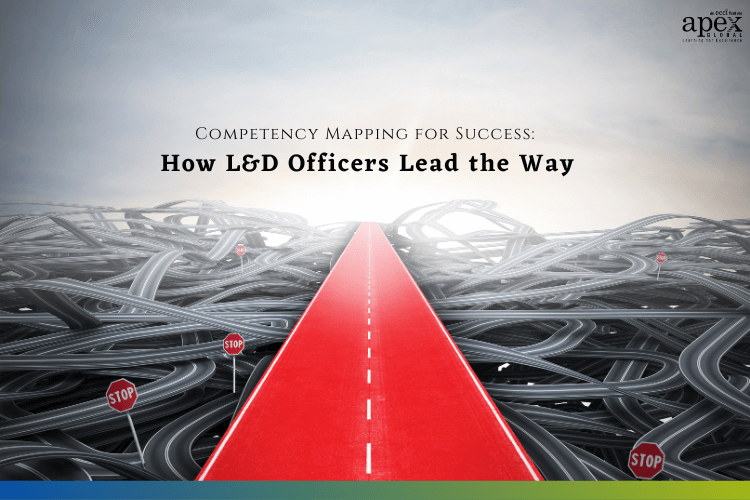Ever heard the saying, “The arrogance of success is to think that what you did yesterday will be sufficient for tomorrow -William Pollard”? It is a powerful reminder of the significance of learning and development (L&D) in ensuring long-term success.
Today, organizations recognize the pivotal role of competency mapping as a vital process for identifying the specific skills, behaviors, abilities, and knowledge required for each role.
In the pursuit of success, organizations today understand that empowering individuals with the right skills and knowledge is the key to achieving long-term goals. This is where learning and development (L&D) officers take the lead by harnessing the power of competency mapping.
Through competency mapping, L&D officers play a pivotal role in tailoring training programs. This helps to meet the organization’s and employees’ unique needs. By doing so, they pave the way for organizational success. Join us in this blog post as we explore how L&D officers lead the charge in driving progress through competency mapping. We will also cover their collaborations with training providers. Of course, we’ll also tackle the challenges they face and explore effective strategies for overcoming them.
What you'll find in this article
- 1 Why L&D is crucial for bridging skills gaps and improving workplace culture?
- 2 What do L&D officers do?
- 3 Challenges faced by L&D Officers
- 4 Needs Analysis and Competency Mapping
- 5 How are KSBs mapped to duties in an occupational standard?
- 6 Engaging with Training Providers and ROI Concerns
- 7 Addressing the biggest fear of L&D officers: Proving ROI
- 8 Final thoughts
Why L&D is crucial for bridging skills gaps and improving workplace culture?
L&D plays a central role in building the skills needed in the new reality. Further, it helps in broadening the perspectives of leaders and their teams. It touches all parts of an organization, from new hires to senior leadership. It also helps weave an organization’s purpose and values into the learning experience. L&D is a continuous process of encouraging professional development, analyzing skills gaps, and designing training programs that empower employees with specific knowledge and skills. By investing in L&D, organizations can bridge skills gaps, improve workplace culture, and increase employee engagement and retention rates.

How does L&D increase ROI and profitability?
Learning and Development (L&D) initiatives have the potential to significantly increase Return on Investment (ROI) and profitability for organizations. Here’s how:
- Improved performance: By investing in L&D programs, organizations can enhance the skills and capabilities of their employees. This leads to improved performance, increased productivity, and ultimately, better business outcomes. When employees have the necessary knowledge and skills to excel in their roles, they can contribute more effectively to the organization’s success.
- Enhanced employee engagement: Learning and Development initiatives demonstrate a commitment to employee growth and development. When employees feel valued and supported in their professional development, they are more engaged and motivated. Engaged employees are more likely to go the extra mile, resulting in increased productivity and higher levels of customer satisfaction.
- Reduced turnover: Investing in L&D shows employees that the organization is invested in their long-term success. This can lead to higher employee retention rates. Employees are more likely to stay with an organization that offers opportunities for growth and advancement. Reduced turnover translates to cost savings associated with recruitment, onboarding, and training new employees.
- Adaptability to change: In today’s rapidly evolving business landscape, organizations need to be agile and adaptable. L&D programs can equip employees with the skills and knowledge needed to navigate change effectively. By fostering a culture of continuous learning, organizations can stay ahead of industry trends and remain competitive.
To ensure that L&D initiatives deliver a positive ROI, it is crucial to align them with organizational objectives and assess their effectiveness regularly. Conducting a training needs analysis and leveraging a skills matrix or competency framework can help. These can tailor Learning and Development programs to address specific organizational needs. By taking a strategic approach and measuring the impact of L&D initiatives, organizations can maximize their return on investment and drive profitability.
What do L&D officers do?
L&D officers are the driving force behind employee development and organizational success. Here’s how they make an impact:
- Fostering a growth mindset: L&D officers empower employees to take responsibility for their own development. They provide access to a variety of training programs that help employees grow and develop their skills.
- Filling skill gaps: The Learning and Development function is critical in filling skill gaps in the workforce while ensuring compliance training expectations are met. L&D officers analyze skills gaps and design training programs to address them effectively.
- Providing innovative learning experiences: L&D officers provide innovative learning experiences that leverage learning content developed inside and outside the organization. They create a culture of continuous learning that helps employees stay ahead of industry trends.
- Developing competencies: Competency mapping is a critical process that helps organizations identify the specific skills, behaviors, abilities, and knowledge required for each role. L&D officers leverage competency mapping to develop competencies among employees, making them more adaptive and competitive.
- Improving ROI: L&D officers strive to improve individual and organizational performance by delivering effective training programs. They ensure that Learning and Development investments deliver a positive return on investment by measuring the impact of training on business results.
Defining the role of L&D officers
The C-suite is always juggling a long list of priorities, and it’s up to the HR to show how L&D intersects with all of them. L&D officers are the superheroes of employee development, filling skill gaps in the workforce while ensuring compliance training expectations are met. By focusing on leadership development, Learning and Development officers can ensure employees have the skills and knowledge to lead effectively. To better understand the multifaceted role of L&D officers, we have compiled a table of L&D officer roles and their definitions:

Challenges faced by L&D Officers
Challenges faced by L&D officers can significantly impact their ability to drive effective learning and development initiatives. Here are some of the common challenges they encounter:
- Tight Budgets: Limited financial resources pose a significant challenge for L&D officers, making it difficult to invest in comprehensive training programs and resources.
- Driving Employee Engagement: Engaging employees in learning activities and ensuring their active participation can be a challenge for L&D officers. Motivating employees to take ownership of their development requires creative approaches.
- Measuring Results: L&D officers face the challenge of effectively measuring the impact of their initiatives on individual and organizational performance. Demonstrating the return on investment (ROI) of training programs is crucial for securing continued support and resources.
- Remote Training and Skill Development: The shift to remote work has presented challenges in delivering effective training and skill development programs. L&D officers must adapt their strategies to engage remote employees and provide accessible learning opportunities.
- Capacity and Resources: L&D officers often face time constraints and limited resources, including senior-level buy-in and budgeting concerns. Balancing competing priorities and securing necessary resources can be a constant challenge.
Superlearning future: Preparing for a future centered on skills and capabilities
Superlearning is the future of learning, and L&D officers need to prepare for it. The challenge is to focus on skills and capabilities at the individual, team, and organizational levels. Superlearning is about integrating learning in the flow of work, powered by data, and across functions and businesses. Successfully scaling up learning in the flow of work requires a well-prepared, well-orchestrated learning transformation. The end goal is what we define as a superlearning environment that fosters skills-based growth, is data-driven, and offers flexible career opportunities. To prepare for this future, Learning and Development officers need to set a strategy for a continuously evolving infrastructure that frequently adapts as the future unfolds. Superlearning requires a simultaneous focus on reskilling, upskilling, and outskilling for a future-proof workforce.
Image content – By 2025, 50% of all employees will need reskilling due to adopting new technology. (World Economic Forum)
Integrating learning in the flow of work: Making learning a part of everyday work
Integrating learning in the flow of work is a game-changer for organizations looking to boost employee engagement and productivity. The concept is about making learning more accessible in the workplace, seamlessly incorporating it into employees’ workdays. Traditionally, learning has happened outside of day-to-day work, often in a separate training session. By integrating learning into the flow of work, employees can learn on the go, without disrupting their workflow. This approach to learning is more engaging and effective, as it allows employees to apply their new knowledge and skills immediately. To implement learning in the flow of work, organizations need to leverage technology, such as a Learning Management System (LMS), and create a culture of continuous learning.
Needs Analysis and Competency Mapping
Conducting a training needs analysis is a critical step in identifying the skills gaps in your organization. It helps L&D officers understand the current competency levels, skills, knowledge, and attitudes of employees and the desired future competency levels. Leveraging a skills matrix or competency framework can help create a roadmap for L&D initiatives. It provides a structured approach to identifying the essential skills and knowledge required for each role. Mapping baseline pathways to cover core role knowledge, skills, and behaviors (KSBs) is another crucial step in defining the essential skills and knowledge required for each role. By identifying the skills gaps and creating a roadmap for L&D initiatives, L&D officers can design training programs that address specific organizational needs and drive business results. Let’s explore the importance of conducting a training needs analysis and competency mapping in designing effective L&D initiatives.
Leveraging skills matrix or competency framework: Creating a roadmap for L&D initiatives
Leveraging a skills matrix or competency framework is a critical step in creating a roadmap for Learning and Development initiatives. A skills matrix is a tool that helps organizations identify the skills and competencies required for each role and assess the current competency levels of employees. A competency framework, on the other hand, is a comprehensive set of competencies that define the knowledge, skills, and behaviors required for each role. By leveraging these tools, L&D officers can identify the skills gaps in the workforce and design training programs that address specific organizational needs.
Mapping baseline pathways to cover core role Knowledge, Skills, and Behaviors (KSBs):
Competency mapping involves breaking down each job, role, or activity into a list of skills, knowledge, abilities, and behaviors. These are known as Knowledge, Skills, and Behaviors (KSBs) and are the backbone of apprenticeship standards and competency frameworks. Here’s how to break down each competency into specific KSBs:
Identify the Competency: Identify the competency or skill that needs to be mapped.
Define the Knowledge: Define the specific knowledge required to perform the competency. This could include theoretical knowledge, industry-specific knowledge, or product knowledge.
Define the Skills: Define the specific skills required to perform the competency. This could include technical skills, soft skills, or leadership skills.
Define the Behaviors: Define the specific behaviors required to perform the competency. This could include communication skills, problem-solving skills, or teamwork skills.
How are KSBs mapped to duties in an occupational standard?
Mapping KSBs to duties in an occupational standard involves identifying the KSBs required to undertake each duty. The occupational standard should be based on a clear occupational profile that sets out the duties carried out by employees in the occupation. This includes the KSBs that will be applied in the workplace. Each KSB is likely to be needed for more than one duty. So, it’s essential to map the most relevant KSBs to each duty. It’s also important to ensure that each KSB is mapped to at least one duty. The KSBs represent the core attributes an apprentice must have to be competent in the occupation they are working in.
The Independent End-Point Assessor (IPEA) tests an apprentice’s competence against the KSBs rather than against the duties that they have developed for the job. By mapping KSBs to duties, L&D officers can design training programs that address specific organizational needs and drive business results.
Engaging with Training Providers and ROI Concerns
Engaging with training providers and measuring ROI is crucial for the success of L&D initiatives. To ensure that training programs are aligned with business goals and drive business results, Learning and Development officers need to work with training providers that offer relevant and engaging content. Measuring the ROI of L&D initiatives helps organizations assess the effectiveness of their training programs and identify areas for improvement. By calculating the ROI of training, L&D officers can demonstrate the value of their initiatives and secure continued support and resources

Partnering with a flexible training provider can help organizations scale their resources as needed. Here are some ways how:
Flexible Delivery Options: A flexible training provider offers a range of delivery options, including online, in-person, and blended learning. This approach allows organizations to scale their resources as needed and deliver training programs that meet the unique needs of their workforce.
Scalability: A training provider can help organizations scale their training programs to meet the needs of a growing workforce. This approach ensures that training remains relevant and impactful, even as the organization expands.
Subject Matter Expertise: A training provider brings subject matter expertise to the organization. They can provide insights into industry best practices, and emerging trends, and help align training initiatives with business goals.
Improved Fixed Resources Scalability: A flexible training partner ensures that the training programs are targeted toward the current gaps. This approach improves fixed resource scalability, allowing organizations to optimize their training resources.
Partnering with a flexible training provider like APEX Global Learning can help organizations scale their resources as needed and drive business results. With a focus on practical and actionable learning, APEX Global Learning offers customized and off-the-rack training solutions that meet the specific needs of organizations.
Addressing the biggest fear of L&D officers: Proving ROI
Measuring and demonstrating the impact of L&D initiatives is a major concern for L&D officers. To avoid poor ROI on development initiatives, L&D officers need to focus on improving individual and organizational performance. Measuring the ROI of Learning and Development initiatives helps organizations assess the effectiveness of their training programs and identify areas for improvement. To measure the ROI of L&D initiatives, L&D officers need to align training to organizational goals and metrics. They need to establish clear channels of communication with business units. Finally, they need to match learning initiatives to measurable business goals and outcomes.
Proving the value of L&D initiatives
Measuring the ROI of L&D initiatives is essential to assess the effectiveness of training programs, identify areas for improvement and demonstrating the impact of training on business results. Here are some common metrics used to measure the ROI of L&D initiatives:
Technology Utilization: Measuring the utilization of technology used in training programs can provide insights into the effectiveness of the training. This includes learning management systems.
Team Outcomes: Measuring the impact of training on team outcomes can provide a clear picture of the ROI of L&D initiatives. This includes productivity, quality, and customer satisfaction.
Qualitative Feedback: Collecting qualitative feedback from employees on the effectiveness of training programs can provide insights into the ROI of L&D initiatives.
Ability to Retain Talent: Measuring the impact of training on employee retention rates can provide insights into the ROI of Learning and Development initiatives.
Attendance Rates: Measuring attendance rates can provide insights into the effectiveness of training programs.
Final thoughts
As the saying goes, “Tell me and I forget, teach me and I may remember, involve me and I learn.” This quote highlights the importance of experiential learning, which accounts for the majority of learning and development. To drive organizational success, Learning and Development officers need to focus on engaging employees in their learning journey. They need to provide opportunities for experiential learning. Competency mapping and engaging with training providers are essential strategies to ensure that employees have the necessary skills and knowledge to excel in their roles. By measuring the impact of Learning and Development initiatives and addressing ROI concerns, organizations can make data-driven decisions for improvement and secure continued support and resources. By leveraging these strategies, L&D officers can create a culture of continuous learning and drive organizational success.


